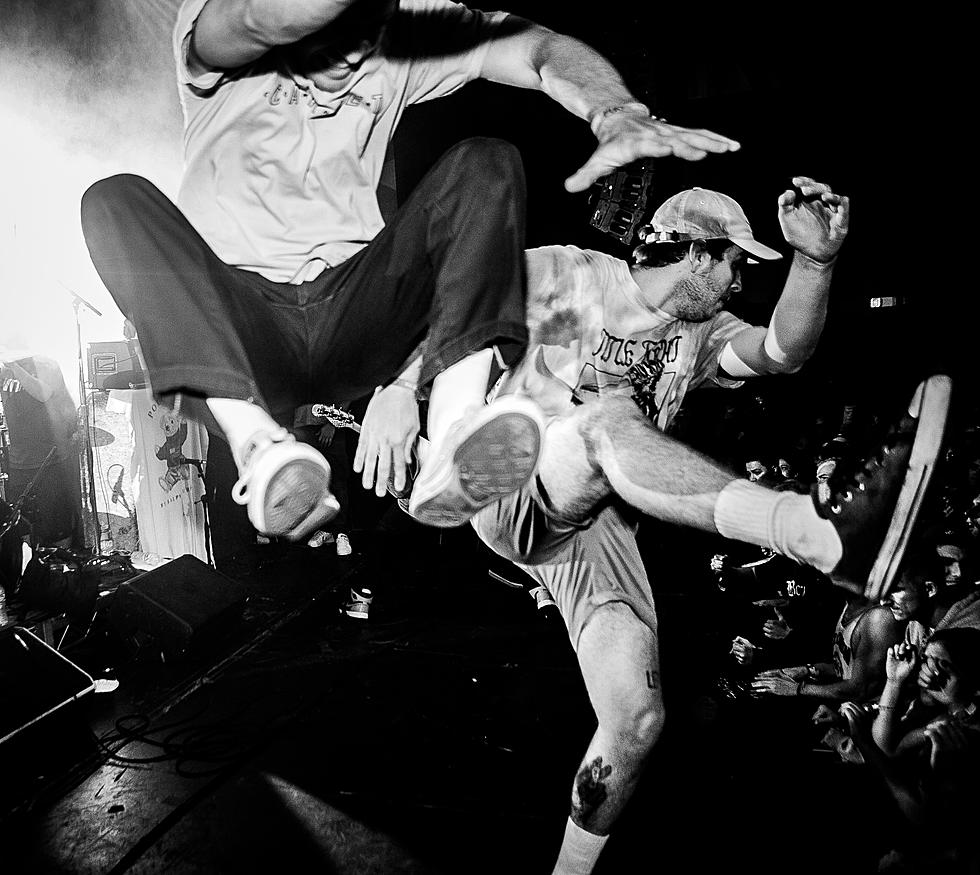
A Crash Course on Some of the Most Extreme Punk in the World
The lore of Japanese hardcore can be traced back to SS, a group formed out of Kyoto in 1977. Documentation of the enigmatic band is limited to only two posthumously released live albums, both of which exemplify the cacophonous lo-fi style that would ultimately define the genre.
Could the impact of these raw recordings have been a happy accident? It's possible that this trend in production could be traced to another arcane group from Kyoto, Le Rallizes Dénudés, whose noisy psychedelic recordings go as far back as the 1960s. The blown out, feedback-drenched style would inspire countless bands to emerge from Japan's burgeoning psych scene in the coming years.
So, the question remains: How much influence did these live recordings — which were quite possibly only lo-fi by necessity — have on those who worshipped them? These sorts of serendipitous occurrences are, of course, not only limited to Japan. In Belgium, for instance, certain DJs were unknowingly (or intentionally?) spinning 45rpm EBM and acid house records at the incorrect 33rpm speed, which in turn influenced their taste for slower beats. And thus, the New Beat genre was born.
Origin stories will forever be a point of contention, but nevertheless, Japanese hardcore has historically demonstrated some of the most experimental, dissonant and artful punk interpretations, a sound that is not necessarily aligned with "hardcore punk" as we know it in the States. First-wave bands like the Comes, Gai, Kuro and the Stalin, were heavily influenced by the UK82 and anarcho-punk scenes, injecting the "D-beat" pulse of Discharge with noisier, more metallic sounds.
But the bar was raised (and possibly never surpassed) by G.I.S.M., one of the earliest and most unusual bands to juxtapose the crusty Japanese sound with glam and speed metal elements. The bizarre vocals and noisy atmosphere would lay the foundation, along with other crucial mid-'80s bands like Lip Cream, Bastard, L.S.D, Death Side and the Clay.
So, if you're looking to spend a few hundred dollars on a rare flexi disc, or if you're just beginning to crack the surface of this genre, here are a some more selections from the vast and esoteric world of Japanese hardcore.
Googol Plex, Nail a Lie to the Counter! (1985)
The only release from Googol Plex is a pinnacle of the genre, with a powerful attack that isn't compromised by the raw production, a sacrifice that is often made on so many of these lo-fi recordings. The drums make this an exceptionally heavy record, augmenting the caveman stompers with wild blast beats.
Chikusyo, Death in Life (1987)
This obscure flexi disc features a late '80s metallic sound, with chorus-laden guitars and reverbed vocals. The B-side really opens up and approaches goth territory before kicking back into some melodic and airy guitar solos. Catchy and fierce with glossier production, compared to the ultra lo-fi tendencies that dominated so much of the first wave of Japanese hardcore.
Ikkashinju, Slow Down (1985)
The production and impeccable mixing make this a really special record, giving Slow Down a certain energy that other mediocre releases are lacking. The vocals sound sufficiently demented, and the guitars are blazingly metallic and noisy as hell.
Inzest, Another Religion ... Another Violence (1987)
Relentless thrash / hardcore crossover flexi release. Chaotic, noisy and ferocious effort that mixes insanely raw vocals with the speed of thrash and the familiar guitar style of classic Japanese hardcore.
Gudon, Fushuu (1984)
The knobbly vocals, caveman beats and lo-fi production on this demo tape practically border on black metal, but occasionally allow for some pounding hardcore moments. Somewhere towards the end, an extended piano interlude precedes some gagging noises before the group returns to form for a brutish outro.
The Swankys, Never Can Eat Swank Dinner (1987)
Gai changed their name to the Swankys in 1985, but it wasn't until 1987 that the group decided to trade in their classic Japanese hardcore sound for a first-wave U.K. punk aesthetic. The result is a raw take on the Sex Pistols and 999, with some truly adept songwriting that proves they were capable of more than just playing fast.
Anti Septic, First Last (1985)
Coveted, but relatively straightforward Japanese hardcore with gnarled vocals and "Motörpunk" riffs that overall sound a lot like Detestation-era G.I.S.M.
Sex Complex Class, Genin Fumei (1985)
Another flexi from a group that sounds like a Japanese version of the Descendents, with fuzzy guitars and mostly mid-paced tempos.
Friction, Atsureki (1980)
Atsureki was the debut full-length from this Japanese No Wave group that probably has more in common sonically with the U.K. post-punk scene than the N.Y. noise scene. Regardless, vocalist "Reck" and drummer Chiko Hige were members of Teenage Jesus and the Jerks and James Chance and the Contortions, respectively, and the influence of the angular, discordant guitar style that Glenn Branca created the blueprint for is certainly present on this groundbreaking album.
Judgement, No Reason Why (1996)
Aggressive '90s hardcore supergroup that features members of Lip Cream, Gudon, Bastard and Death Side. Sounds less like standard Japanese hardcore and more like late '90s American hardcore.
Aburadako, Aburadako (1983)
The name means "Greasy Octopus." Dripping wet, disgusting art-punk that sounds like something Toxic State would have put out in 2010. The fast stuff is full of snot and blown-out thrashing drums, and then suddenly "Aburadako 4" and "Aburadako 6" enter the mix at a stomping pace with some intensely throaty vocals that could have served well on a powerviolence track.
Crow, Who Killed Dove? (1985)
Crusty hardcore that is both classic and representative of the Japanese sound. Nice balance of fuzz and clarity with Discharge-inspired vocals. Crow's best tracks can be found on the 1988 Eye of the Thrash Guerrilla compilation, which also features Death Side and Japanese grindcore legends S.O.B.
Outo, Many Question Poison Answer (1984)
Intense noisecore with ferocious vocals and blistering, trebly riffs. Like most noisecore releases, the bass and drums provide a barebones structure beneath the piercing guitars.
Baws, Like Let's Have a Ball! (1984)
Totally bizarre, but infectious lo-fi Oi! weirdness that is only rivaled by Cobra on their 1983 EP, Break Out. Goofy and anthemic street punk made by Japanese skinheads.
Mobs, Projection of Astral Body (1985)
Things really get interesting on the B-side (which is actually listed as the "Z-side"), when the creepy goth interlude "Stormy Night" seemingly comes out of nowhere. Mobs' aesthetic and dark themes both set them apart and add a morbid flavor to Projection of Astral Body, despite being slightly less raw than the Diabolism EP.
World, Why Who What (1996)
Debut 7" EP from the infamous noisecore group that features only a drummer and two vocalists. The absence of a guitar does not detract from the heaviness of this record, with short, dissonant grindcore songs that are rooted in the genre's crusty foundation.
Kikeiji, Hello-Good Bye (1985)
Melodic and strange, with some ass-shaking riffs bordering on hair metal. A far cry from their previous EP, Pressure, a hardcore release that was heavily indebted to late-era Black Flag.
Zouo, The Final Agony (1984)
Dark, atmospheric and extremely evil-sounding crusty hardcore. The first official release from this group, the blown-out vocals and satanic overtones of The Final Agony make for a unique and terrifying album.
The Star Club, Hello New Punks (1982)
Melodic punk that immediately brings to mind Zero Boys; both groups had a catchiness and dominant Ramones influence that was elevated by a hardcore sense of urgency. The Star Club demonstrate some really unique guitar work and incredible songwriting on this underrated EP that needs to be heard.
Kyojinbyo, Black Current Hard Coar (1987)
Yet another flexi that features a female vocalist who gives Wendy O. Williams a run for her money. The guitars on this album sound completely washed out, and practically disappear behind the maniacal voice and pounding drums.
Dust Noise, Healthy Filthy Noise Attack (1998)
The "guitar" tone on this album is pure static noise, occasionally hard to endure, but nevertheless the key element for this landmark effort for the noisecore genre.
Gas, The Day After (1984)
The female vocals and add a nice flavor to The Day After, a formulaic, but standout EP that perseveres thanks to some creative and varied songwriting.
Innocents, Masho (1988)
One-off crossover EP, showing signs of the late '80s transition into thrash, a bandwagon that so many hardcore bands across the globe would jump on, Japan being no exception.
More From CLRVYNT









